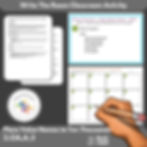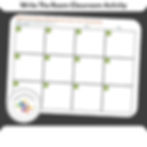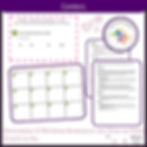
How does your student measure up?
The information in this article will help you objectively assess their current performance levels and write a goal for them with perfectly aligned objectives that steadily progress toward grade-level standards.
Step-by-step instructions for how to review your students’ present performance levels and write a scaffolded IEP goal with perfectly-aligned objectives that steadily progress your student to grade-level standards
This is not going to be your average blog article about how to write a SMART goal. We all went to school and probably learned from the same books about how to make a goal specific, measurable, attainable, blah blah blah.
So, let's dive in and start thinking about the why rather than the how. In some ways, an IEP goal is a teacher's pledge to each student and their families about where we are going to take their education in the coming year. We write them in anticipation of reaching the highest heights.
To reach those heights, we need to build an appropriate learning ladder for the student to climb.
Learning Ladders
A learning ladder consists of rungs just as if climbing a ladder. With each step up a new skill to accomplish getting closer and closer to the top or primary IEP goal. Every new skill builds upon the previous skill to be solidified and retained for future growth.
The first rung indicates what the student can currently do and do well.
The next rung is the first of many baby steps that we will teach over a year, bringing the student closer to grade-level expectations.
Each sequential rung climbed adds to the development of knowledge gained through natural learning progression.
Now, on to determining what those scaffolds are going to look like in an IEP goal and the nuts and bolts of how to teach it.
Determining the Scaffolds
Let’s use a sample student named Michael Washington.
Michael's latest general education assessments indicate that he struggles with addition and subtraction, specifically multi-digit problems. His teacher reports he has been struggling for a while but is unsure where the learning got disconnected. His latest evaluation is two years old and he’s not due for a review for another 12 months.
Finding the First Rung
We are going to start with the basics to determine what skills Michael currently has and go up the ladder from there. During the process of walking through the standards, if at any point you decide that this is your baseline, STOP! You can start writing your goal – this is the first rung on the student’s personal learning ladder.
Continuing with our example:
Can Michael tell the number names and the count sequence?
Yes - Move to next rung
No - Look further back in the learning progression to find a better matched path
Can Michael count forward beginning from a given number within the known sequence (instead of having to start at 1)?
Yes - Move to next rung
No - Set this and the first quarterly objective to master
Can Michael write numbers from 0 to 20? Represent a number of objects with a written numeral 0-20 (with 0 representing a count of no objects)?
Yes - Move to next rung
No - Set this and the first quarterly objective to master
Can Michael, when counting objects, say the number names in the standard order, pairing each object with one and only one number name and each number name with one and only one object?
Yes - Move to next rung
No - Set this and the first quarterly objective to master
Does Michael understand that the last number name said tells the number of objects counted, regardless of their arrangement or the order in which they’re counted?
Yes - Move to next rung
No - Set this and the first quarterly objective to master
Does Michael understand that each successive number name refers to a quantity that is one larger?
Yes - Move to next rung
No - Set this and the first quarterly objective to master
Are you starting to catch on? Let keep going and follow this all the way through.
The Final Rungs on the Learning Ladder
Here are the last few standards of processing through. This is probably more than you need, but I wanted you to have options for future students. I hope this gives you a good understanding of writing a ladder and how the slide chart would help identify your rungs.
Can Michael count to answer "How many?" questions about as many as 20 things arranged in a line, a rectangular array, or a circle, or as many as 10 things in a scattered configuration?
Yes - Move to next rung
No - Set this and the first quarterly objective to master
Can Michael identify whether the number of objects in one group is greater than, less than, or equal to the number of objects in another group, e.g., by using matching and counting strategies?
Yes - Move to next rung
No - Set this and the first quarterly objective to master
Can Michael represent addition and subtraction with objects, fingers, mental images, drawings, sounds (e.g., claps), acting out situations, verbal explanations, expressions, or equations?
Yes - Move to next rung
No - Set this and the first quarterly objective to master
Can Michael solve addition and subtraction word problems and add and subtract within 10, e.g., by using objects or drawings to represent the problem?
Yes - Select a higher-level goal for this student
No - Set this and the first quarterly objective to master
Writing the IEP Goal
After considerable review, it was determined that Michael’s skills started to decline when manipulatives and visual aids were removed. When a math problem was written in linear or stacked formations, he struggled to conceptualize the numbers as objects to be counted.
It would be recommended that he do a review of solving addition problems up to five with the implementation of touch math to support. This would be the first rung on his learning ladder.
If needed, the second rung could be addition problems with sums up to 10, and the third and fourth rungs would be subtraction to five and 10.
You would set his goal at “addition and subtraction to 10.”
If Michael moved faster through the ladder than the one-year timeline, extending this goal would include the addition and subtraction of double-digit numbers. Write this in the Math section of the IEP. This shows the parent that you have a plan to move slow and steady, and a method for extension should it go better than expected.
If Michael is a rock star and catches on very quickly, triple-digit addition and subtraction can easily be implemented. Never be afraid to extend the goal higher. No parent ever complained if their child did better than expected!
| Other helpful information you might like |
|
How many rungs should my learning ladder have?
There are a few ways to think about how many rungs your ladder is going to need to accommodate a full year's worth of growth. Because each child is different and each disability is different, a year for one student is not the same as a year's growth for another.
Here is a loose guide to help in your decision:
MILD DISABILITIES – If a student can be part of the general education classroom, their disability can range from mild to moderate. A one-year goal will have four rungs on the ladder or objective, scaffolding the student to goal mastery.
MODERATE DISABILITIES – This category includes students with specific learning disabilities, speech impairments, and students who struggle with reading or math. A one-year goal will have two rungs on the ladder or objective, scaffolding the student to goal mastery.
SEVERE DISABILITIES – This category includes students with disabilities that hinder their success if not accompanied by an adult. A one-year goal will have one rung on the ladder or objective, scaffolding the student to goal mastery.
Whether you're writing goals for a school IEP or just need some tips on how to write standards-based academic and behavior objectives, we’ve got you covered.
We have an expert team of writers who can help with all your needs and will take the time to understand what it is that you want before they even start their work!
Which specific objective do you feel most confident about?
































